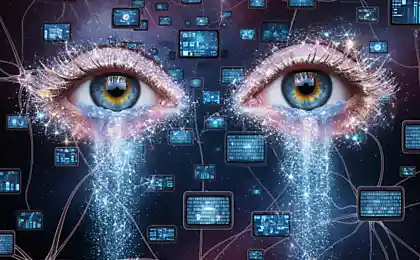348
How to keep your eyes healthy for years to come

Eye health is the key to a quality life for many years
The human body is a well-established mechanism in which all organs and systems are interconnected and function as a whole. The eyes are one of the most precious organs that gave us the opportunity to know the world in all its many colors. However, the modern lifestyle with its digital devices, poor ecology and constant stress creates an unprecedented strain on our vision. How to keep your eyes healthy in these conditions and ensure clear vision for many years?
According to the World Health Organization, more than 2.2 billion people worldwide have vision problems, with half of them preventable with proper prevention. Our vision is the result not only of a genetic predisposition, but also of our lifestyle, diet and eye care habits.
Physiology of vision: why the eyes are prone to problems
The eye is a unique and extremely complex organ that does a tremendous job every day. About 90% of information about the world passes through the eye. In order to understand how to keep your eyes healthy, it is important to understand the main reasons why vision can deteriorate:
- Constant tension Long-term work at the computer, reading in poorly lit places;
- Age-related changes the natural aging process of the lens and other structures of the eye;
- Metabolic disorders - especially in diseases such as diabetes;
- Nutrient deficiencies - vitamins A, C, E, lutein and zeaxanthin;
- UV exposure Long stay in the sun without protection;
- Environmental factors Air pollution, allergens, tobacco smoke.

Eye Anatomy and Nutrients Required for Its Health
An Integrated Approach to Eye Health
Maintaining eye health requires a systematic approach that includes several key areas.
Nutrition for Eye Health
The eyes are particularly sensitive to the quality of food. Studies show that certain nutrients can significantly slow age-related vision changes and prevent disease.
Top 7 Nutrients for Eye Health:
- lutein and zeaxanthin Natural pigments that accumulate in the macula (central part of the retina) and protect the eyes from harmful blue light. Sources: spinach, kale, broccoli, corn, egg yolks.
- Omega-3 fatty acids Support the structure and function of retinal cell membranes. Sources: fatty fish (salmon, tuna, sardines), flaxseed oil, walnuts.
- Vitamin A It is necessary for the work of photoreceptors and the production of rhodopsin. Sources: liver, carrots, sweet potato, pumpkin, red pepper.
- Vitamin C An antioxidant that protects eye vessels and prevents the development of cataracts. Sources: citrus, kiwi, strawberries, broccoli, Bulgarian pepper.
- Vitamin E Protects eye cells from oxidative stress. Sources: almonds, sunflower seeds, vegetable oils, avocados.
- zinc It helps the body absorb vitamin A and is involved in the exchange of melanin in the eyes. Sources: oysters, beef, pumpkin seeds, lentils.
- Anthocyanins improve microcirculation in the vessels of the eyes and strengthen the capillaries. Sources: blueberries, blackberries, blackcurrant, cherries.
Optimal working and rest regime
Proper eye mode is key to preventing fatigue and overstrain. Modern man spends in front of the screens from 8 to 12 hours a day, which creates a huge load on the visual system.
Studies show that when working at a computer, the blinking frequency decreases by about 3 times - from 15-20 to 5-7 times per minute. This leads to drying of the cornea and the development of dry eye syndrome.
Rule 20-20-20
One of the most effective and simple ways to reduce eye strain is the 20-20-20 rule recommended by the American Optometric Association.
Every 20 minutes of work behind the screen, take a 20-second break and look at an object at least 20 feet away (about 6 meters). This helps to relax the eye muscles and reduce tension.
Eye gymnastics
Special exercises for the eyes help train the eye muscles, improve blood circulation and relieve fatigue. Regularly performing these exercises can significantly improve vision.
5 effective exercises for the eyes:
- palming Close your eyes with your palms without pressing your eyeballs, and create complete darkness for 1-2 minutes. This helps to relax the muscles of the eyes and improve blood circulation.
- Focus. Take a pencil, stretch out your hand and focus on its tip. Then slowly approach the pencil to the nose without losing focus. Repeat 10-15 times.
- Eye rotation Slowly rotate your eyes clockwise and then counterclockwise, trying to cover the maximum amplitude. Repeat 5-10 times in each direction.
- Squeezing Close your eyes tightly for 5 seconds, then open them wide for 5 seconds. Repeat 7-10 times. This exercise helps to improve blood circulation.
- Diagonal movement Look in the upper right corner, then in the lower left. Repeat 5-10 times, then change direction: top left – bottom right.
Protecting the eyes from external influences
Current research confirms that protecting the eyes from UV and blue light is critical for long-term vision health.
Basic eye protection measures:
- Wearing quality sunglasses UV filter 400, especially in mountains, on water and on sunny days;
- Use of glasses with protection from blue light with prolonged work at the computer or using a smartphone;
- Setting up screens Reducing brightness, using night mode, applications for filtering blue light;
- Proper lighting of the workplace It should be sufficient, but not excessive, and not create glare;
- Avoiding dry air in the room Use of air humidifiers if necessary;
- Protect your eyes during potentially dangerous work Use of safety glasses when working with chemicals, during construction, etc.

Ergonomic workplace that promotes eye health
Regular examinations by an ophthalmologist
One of the key aspects of maintaining eye health is the timely diagnosis of potential problems. Many serious eye diseases in the early stages are asymptomatic, and a person may not be aware of them until irreversible changes develop.
Recommended frequency of examinations by an ophthalmologist:
- Under 40 years of age every 2-3 years in the absence of complaints;
- 40 to 65 years old - every 1-2 years;
- After 65 years - annually;
- If there are risk factors (diabetes, glaucoma in the family history, high myopia) - annually regardless of age;
- When using a computer actively - at least 1 time a year.
Innovative methods of prevention and treatment of eye diseases
Modern ophthalmology does not stand still. New technologies and techniques are emerging to preserve vision even in the presence of serious problems.
Recent research in regenerative medicine shows the promise of using stem cells to repair damaged retina. Clinical trials of treatments for age-related macular degeneration using cellular technologies are already underway.
An Integrative Approach to Eye Health
It is important to understand that the eyes are not an isolated organ, but part of the overall body system. Eye health directly depends on the state of the entire body.
General health factors affecting vision:
- Blood pressure control - hypertension can lead to damage to retinal vessels;
- Normalization of blood sugar levels Diabetic retinopathy is the leading cause of blindness among people of working age.
- Quitting smoking Smoking increases the risk of cataracts and age-related macular degeneration by 2-3 times;
- Maintaining a normal weight Obesity is associated with an increased risk of glaucoma and diabetic retinopathy;
- Regular physical activity improves blood circulation, including in the vessels of the eyes;
- Full sleep. During sleep, the eyes are restored and moisturized.
Glossary
Macula (yellow spot)
The central part of the retina, responsible for central vision and distinguishing small details. It contains the highest concentration of photoreceptors.
glaucoma
A group of diseases characterized by increased intraocular pressure, which leads to damage to the optic nerve and loss of vision.
cataract
Clouding of the lens of the eye, leading to a gradual decrease in vision. Most often it develops with age.
Dry eye syndrome
A condition in which the eyes do not produce enough tear fluid or the tear film evaporates quickly, leading to discomfort, redness and irritation of the eyes.
Age-related macular degeneration (AMD)
Progressive disease affecting the central part of the retina (macula), which leads to loss of central vision. One of the leading causes of blindness in people over 50.
asthenopia
Visual fatigue, manifested by discomfort, pain around the eyes, blurred vision after prolonged visual work.
Accommodation
The ability of the eye to change focal length to clearly see objects at different distances from the eye.
rhodopsin
Light-sensitive protein contained in the rods of the retina and responsible for twilight vision.
Conclusion
Vision is one of the most valuable gifts of nature, allowing us to fully perceive the world around us. In today’s world, with its digital technologies and environmental challenges, maintaining eye health is becoming increasingly challenging. However, the right integrated approach to this issue can not only prevent vision problems, but also significantly improve the quality of life.
Remember that eye care is not a one-time event, but a way of life. A balanced diet rich in antioxidants and omega-3 fatty acids, regular breaks when working at the computer, protection from ultraviolet radiation, gymnastics for the eyes and timely visits to the ophthalmologist - all these components will help you maintain sharp vision for many years.
Investing in eye health today is investing in the quality of your life tomorrow. As the old saying goes, the eyes are the mirror of the soul and the window to the world. Take care of your eyes and they will serve you for years to come.
How to learn to think big to achieve more
How Not to Become a Marketing Victim: The Art of Countering Corporations























